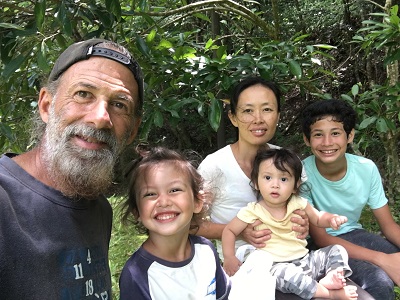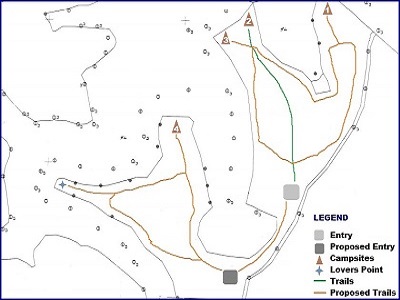 Agroforest
Mission Agroforest
Mission
We were residents of Tanegashima for about three years and were beginning our
journey to self-sufficiency via farming. Eventually we returned to America in
order to sell our home from which we used the proceeds to purchase another home
in the mountains of California. After three months we began missing the island.
Three months later we sold the mountain house and returned to Tanegashima and
purchased a home. We immediately went back to farming using our knowledge gained
during our first three years on the island. Then three years later, with six
years of farming experience under our belts, we decided to take the next step,
which turned out to be agroforestry. We purchased our forested mountain and we are
now at the beginning of what will be an extensive agroforestry project. Many
years of neglect have pushed the forest currently into a state of decline. Huge
vines, some up to 10 centimeters in diameter encircle the majority of our trees,
and once they reach the canopy, cover the tree canopies with vine leaves,
eventually cutting out the sunlight, and weakening the trees. In addition, the
forest is filled with small understory trees which also cut out the sunlight and
compete for nutrients with the larger trees. Our mission is to, first and
foremost, return our mountain forest back to a healthy condition. |
|
|
Our Motivations
During six years of farming on Tanegashima, I was amazed to see the amount of
chemical fertilizers and pesticides used by the local farming community. The
runoff from these chemicals was destroying the coastal waters around this long
and narrow island. The locals often tell stories of how the fishing industry has
diminished over the years and now many prized food fish can no longer be caught.
In addition, many pests and various types of fungus have become much stronger
making the use of control chemicals futile at best. The island is famous for
anno imo sweet potatoes, with the industry now being threatened by a fungus
which damages entire crops. Although still edible, many sweet potatoes are no
longer salable due to what picky consumers might refer to as unsightly blotches.
We thought there must be a better way. All of our farms are 100% organic. We produce food that, although is smaller and not as pretty as the local
farmers, is much more nutritious and definitely tastes better.
We love being in Japan, and in particular, Tanegashima island. That said, we are
very sad to see the direction the island, and in fact, all of Japan is heading.
More and more the farming community is polluting the oceans and this wonderful
country. We wanted to do something to change this awful trend. Then we found the
mountain property and saw an opportunity to make a difference. We are hoping
through our agroforestry project, we can convince the local farmers of a better
way of farming. A way that is sustainable yet still profitable. Our project has
begun. |
|
General Mission
The following are the mission goals we are trying to achieve through our agroforestry project: |
- Create a sustainable land management system
- Engage in farming methods which use only organic
materials and result in minimal changes to the existing natural flora
- Show that mountainous, forested land can be utilized to
produce high yields and be profitable
- Increase the biodiversity of our forest
- Improve soil structure and health
- Reduce erosion
- Increase carbon sequestration through the selective
planting of trees and shrubs to compensate for the removal of native
vegetation
- Incorporate organic methods for pest control
- Create an agroforest that is both productive and
aesthetically pleasing
- To educate others about our successes
- To be part of what we hope will be a growing trend
towards food production which, not only provides for the present, but is
100% sustainable and beneficial to future generations
|
|
 Specific Agroforest Plan Specific Agroforest Plan
These are the step by step details of how we plan to tackle our daunting
agroforestry project.
Purchase the property -
Completed. On July 15, 2021, we closed the Japanese equivalent of escrow.
Make access easier - Completed. Our property is
accessed via a publicly "maintained" dirt road. The road was overgrown
and was obviously not being maintained. We cut many termite infested
trees and shrubs which were overgrown and scratching our truck each time we used
the road. We had planned to push the city to once again maintain the road but
they said no way. The road was apparently built to facilitate construction of the
dam and reservoir
and is now basically unused. We ended up maintaining the road ourselves and now
have could access to our land.
Establish a parking area -
Completed. We
made a suitable space for parking directly off the dirt road. We are now
in the process of expanding this area to make it easier to turn our truck
around....the dirt road is not a through road.
Make hiking trails to each of the campsites -
Completed. We already mapped out the locations of the campsites and made trails
to each one of them.
Make the campsites usable - In progress.
Make interior trails - Planned. Make numerous
trails to access all campsites, points of interest, and food production zones.
Remove understory trees - In progress. Remove all
understory trees less than four meters in height or with a trunk diameter of ten
centimeters or less with the exception of the following tree types: hinoki and
sugi. The goal is to increase morning and afternoon filtered sunlight while keeping tall
tree canopies which will provide shade during the hottest hours of the day.
Remove shrubs - In progress. Remove shrubs to
allow for the planting of edibles.
Remove unhealthy trees - In progress. Remove all
trees that are no longer living, termite infested, or showing excessive damage
from vines.
Make tree choices - Planned. Decide which trees
will provide food and be the best fit for the forest environment from the
standpoint of biodiversity.
Make agriculture choices - Planned. Choose the
best things to grow based on a number of factors including, but not limited to:
topography, sunlight, soil conditions, insect and deer resistance. |
|
|